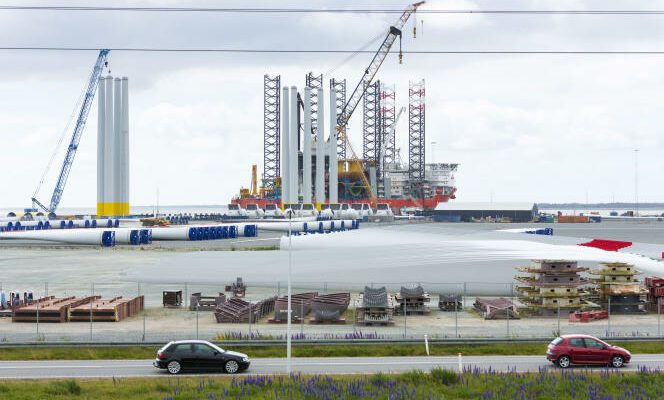In the port of Esbjerg, on the west coast of Denmark, everything seems gigantic: wind turbines, which lie in pieces on the quays waiting to be assembled, passing by the huge ships, where the turbines will be hoisted to the he help of slender cranes, before setting sail, heads for offshore parks all over Europe. “The goal is to make as many preparations as possible on land, in order to be able to install them in a few hours on site”explains Jesper Bank, commercial director of the port.
Gray beard and thin rectangular glasses, Mr. Bank does not sulk his pleasure: a little more than one hundred and fifty years after its inauguration in 1868, the port of Esbjerg has again succeeded in its transformation. Long the leading fishing port in Denmark, transformed into a service center for the gas and oil industry in the North Sea in the 1970s, it is now one of the largest base ports in the world for offshore wind power. More than 80% of the capacity installed in Europe transited there.
Like Denmark, the port of Esbjerg is overwhelmed with projects. All the giants of wind energy are represented there. They are not the only ones: a new generation of actors is arriving, specialized in “Power to X” or P2X – which designates the conversion of electricity into other energy vectors. Examples: the Danish company European Energy, which will soon produce green hydrogen in Esbjerg, intended for boats moored in the port, while the largest green ammonia plant in Europe, financed by Copenhagen Infrastructure Partners (CIP), the first global fund manager dedicated to renewable energies, will be inaugurated there in 2027.
European regulation
And yet, Mr. Bank does not hide his impatience. Because the needs generated by the decarbonization of the economy and society are enormous. On December 14, 2022, the new Danish government, led by Social Democrat Mette Frederiksen, allied with the Liberal Party and the Moderates (center right), decided to bring forward by five years the objective to achieve carbon neutrality, now set to 2045. From 2030, CO emissions2 must have fallen by 70% (compared to 1990).
However, although 80% of the electricity used in Denmark comes from renewable energies, the energy mix of the country of 5.9 million inhabitants – whose Parliament banned the use of nuclear energy in 1985 – remains dominated by renewable sources. carbonated. To remedy this, the kingdom intends to invest massively in wind power, which already provides nearly half of its electricity production.
You have 76.61% of this article left to read. The following is for subscribers only.
